Abstract
1. The effects of several muscarinic agonists on atrial tension development, ventricular rate and noradrenaline release from terminal sympathetic fibres evoked by electrical nerve stimulation (SNS) and 1,1-dimethyl-4-phenylpiperazinium (DMPP) were measured in isolated perfused rabbit hearts.
2. Hexamethonium, in a concentration which almost abolished the release of noradrenaline by DMPP, had no effect on the release produced by SNS, confirming that the stimulation was postganglionic.
3. The order of potency for inhibition of atrial tension development was N-methyl-1,2,5,6, tetrahydro-nicotinic acid prop-2-yne ester (MH-1)>oxotremorine > acetylcholine > methacholine > carbachol > furtrethonium > pilocarpine>4-(m-chlorophenylcarbamoyloxy)-2-butynyltrimethylammonium chloride (McN-A-343)>N-benzyl-3-pyrrolidyl acetate methobromide (AHR 602). All effects were abolished by atropine (1·4 × 10-6M).
4. Each compound was more potent relative to acetylcholine in inhibiting ventricular rate than atrial tension. With the exception of carbachol, the order of potency was the same.
5. Both AHR 602 and McN-A-343 facilitated the release of noradrenaline by SNS and inhibited that by DMPP. The effects were atropine-resistant and hence non-muscarinic.
6. The muscarinic compounds (except AHR 602 and McN-A-343) each produce atropine-sensitive inhibition of noradrenaline release evoked both by SNS and DMPP although it is likely that furtrethonium and pilocarpine have additional non-muscarinic inhibitory activity against DMPP. The order of potency on both parameters and the potencies relative to acetylcholine were in good agreement with those for inhibition of atrial tension.
7. The results suggest that similar muscarinic receptors mediate inhibition of atrial tension development, ventricular rate and neuronal noradrenaline release caused by SNS and DMPP.
8. In terms of the two muscarinic sites known to be present in the superior cervical ganglion, the receptors of the terminal fibres mediating inhibition of noradrenaline release are more likely to correspond to those mediating hyperpolarization than to those mediating depolarization, for which AHR 602 and McN-A-343 show specificity.
Full text
PDF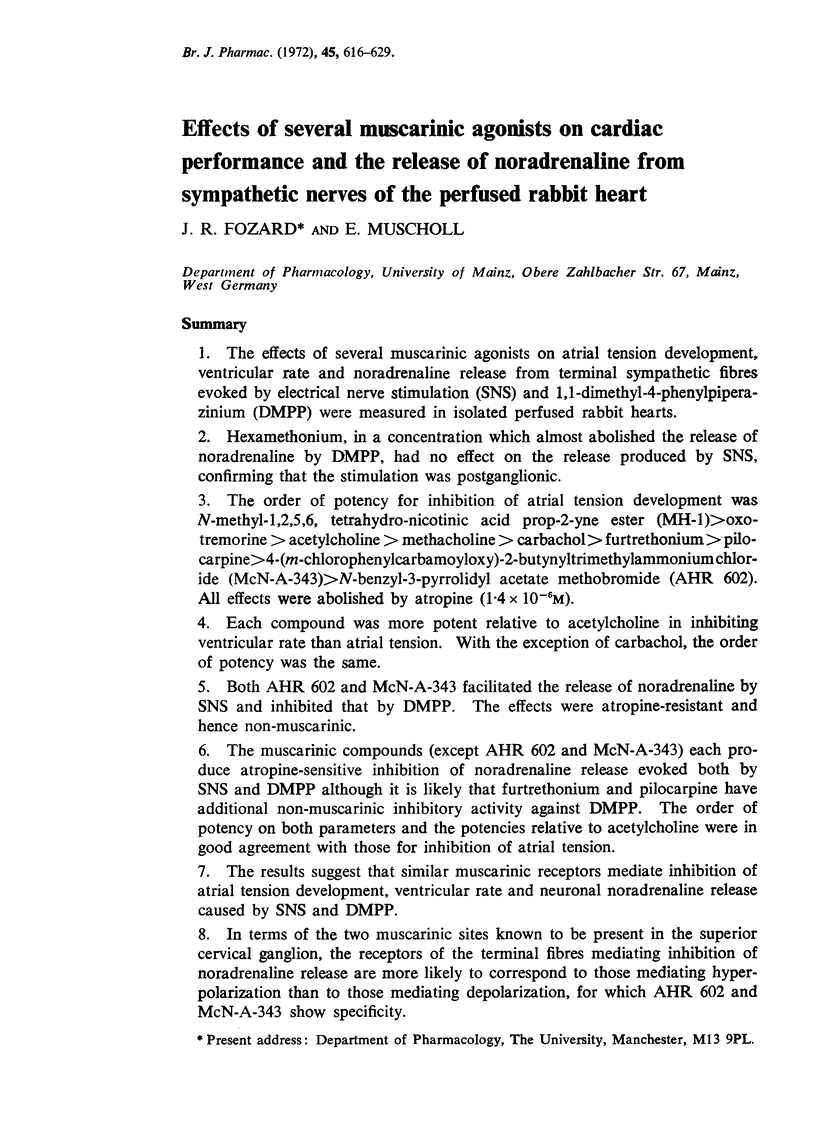
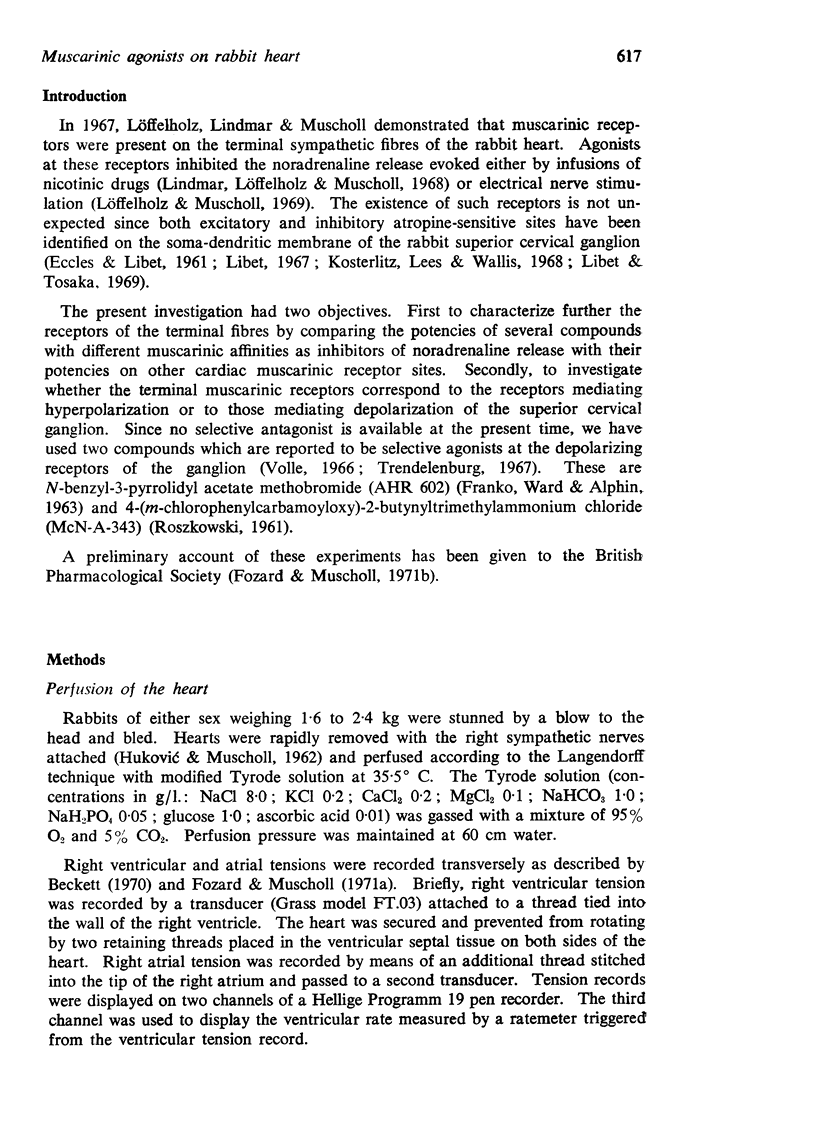
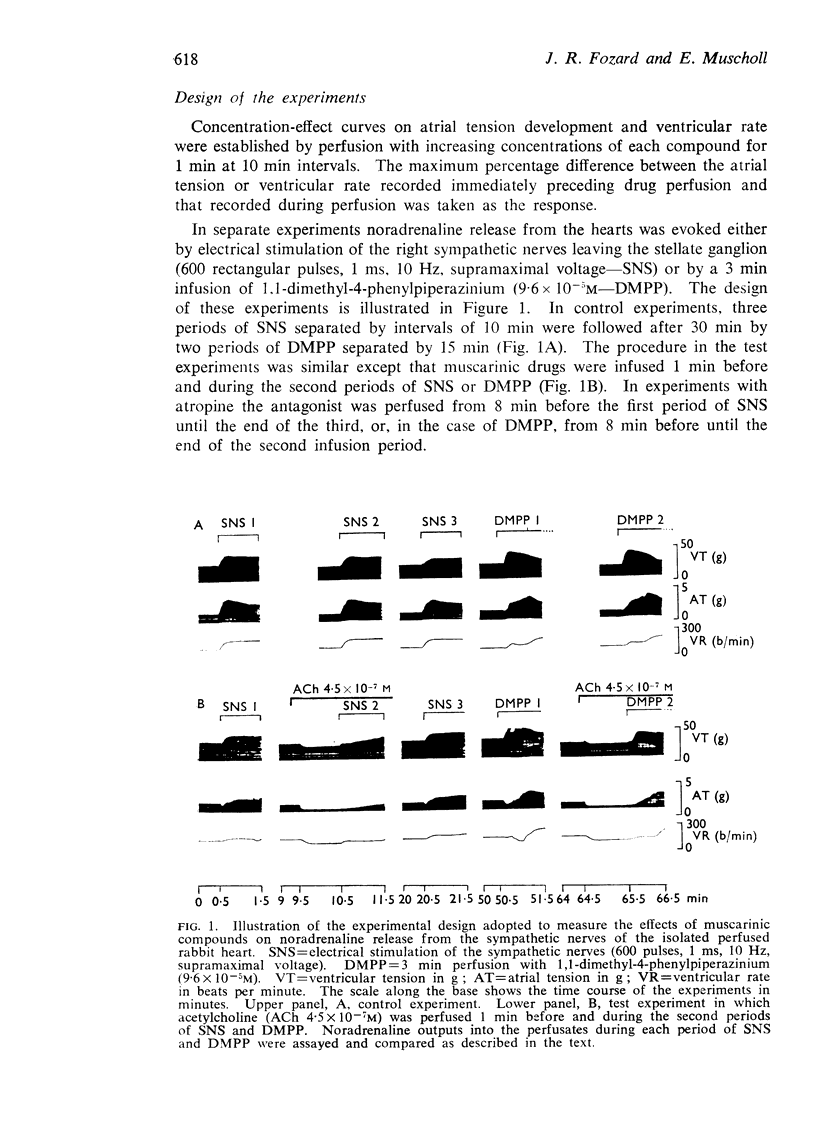
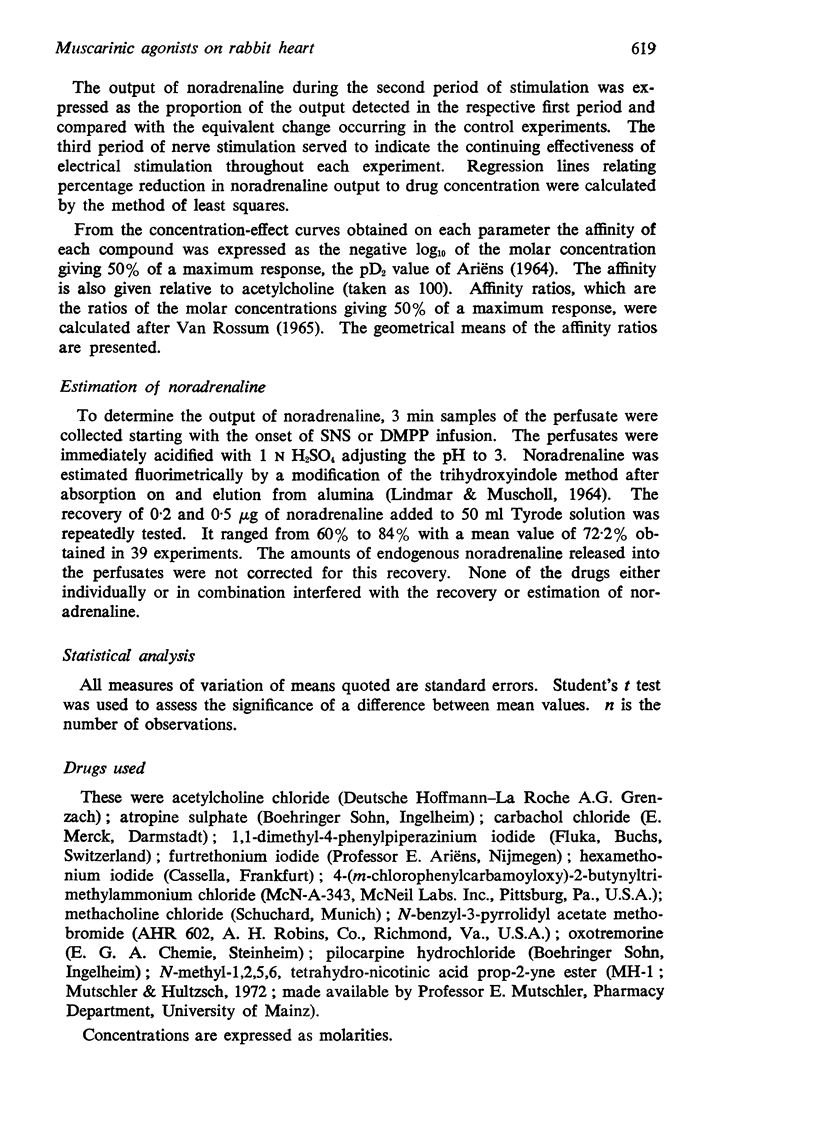
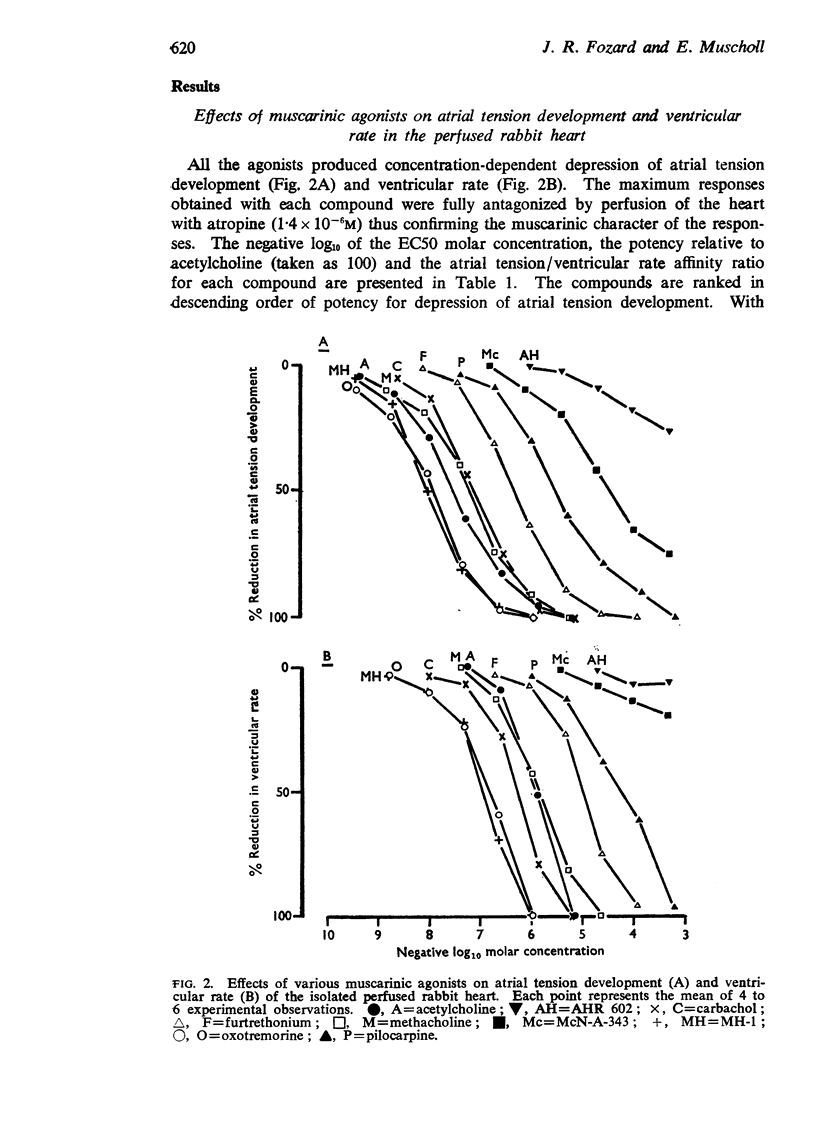
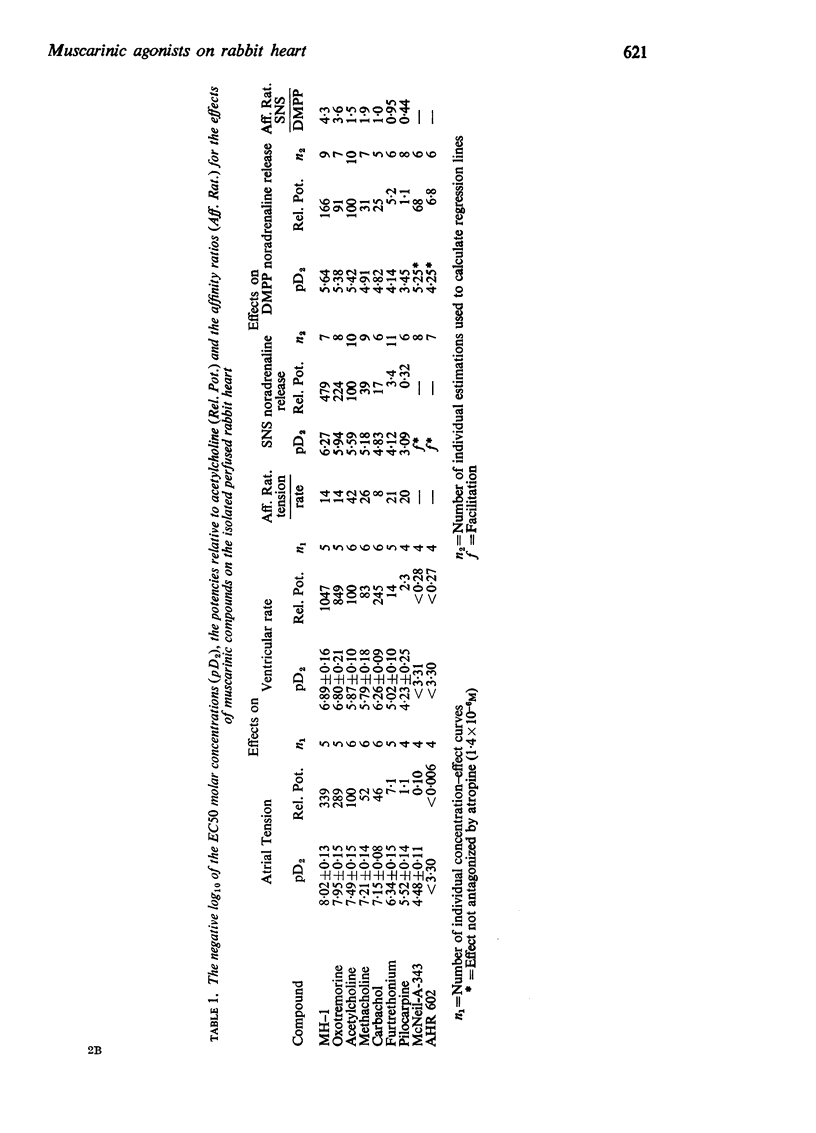
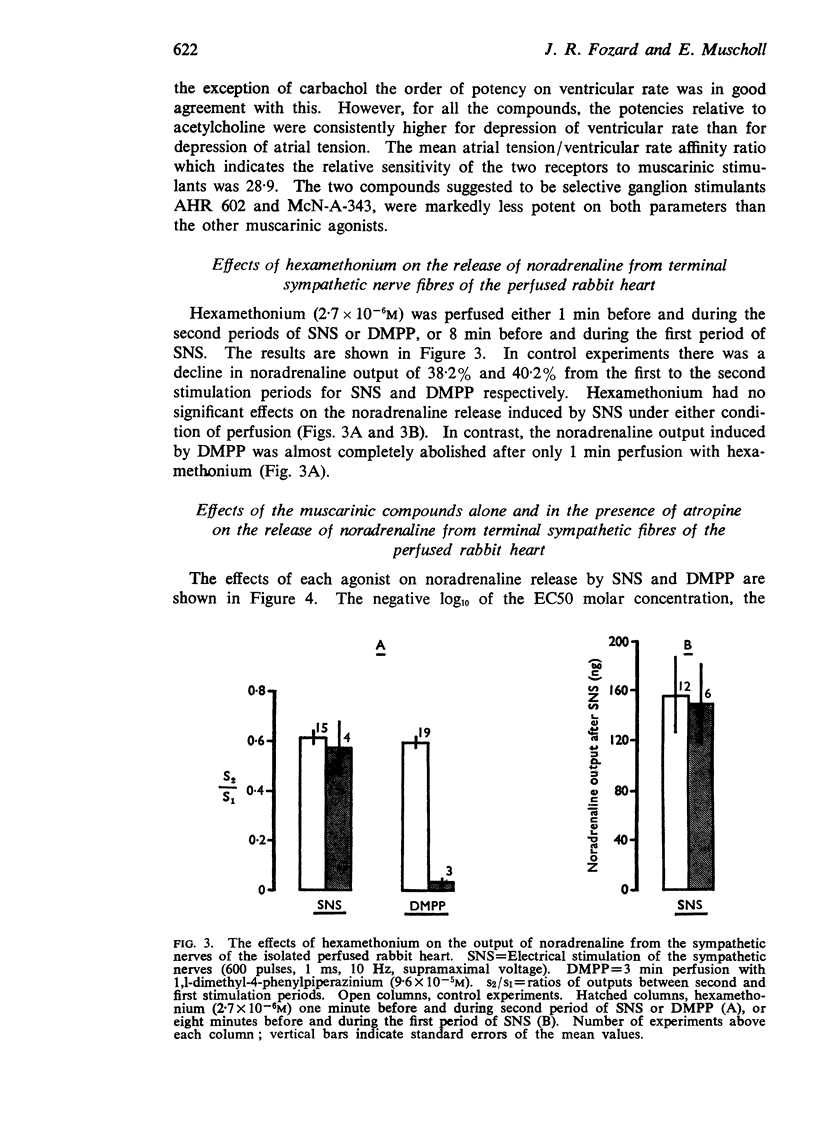

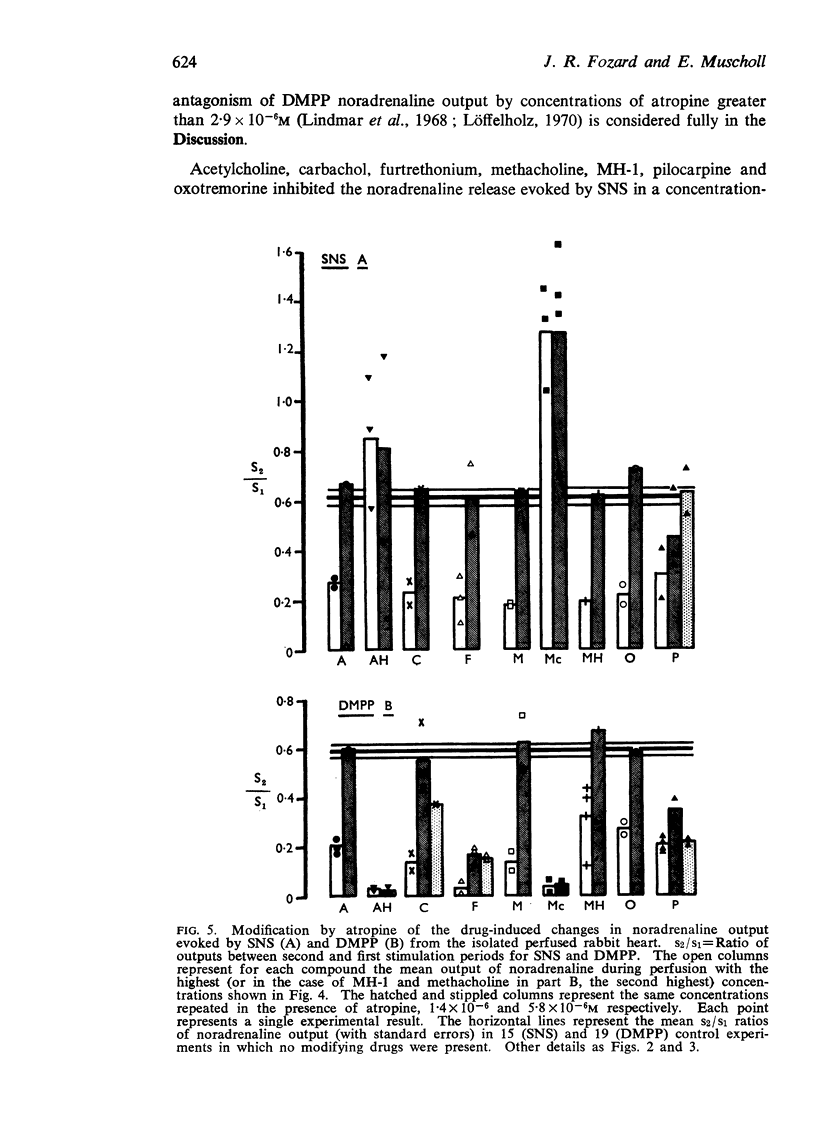
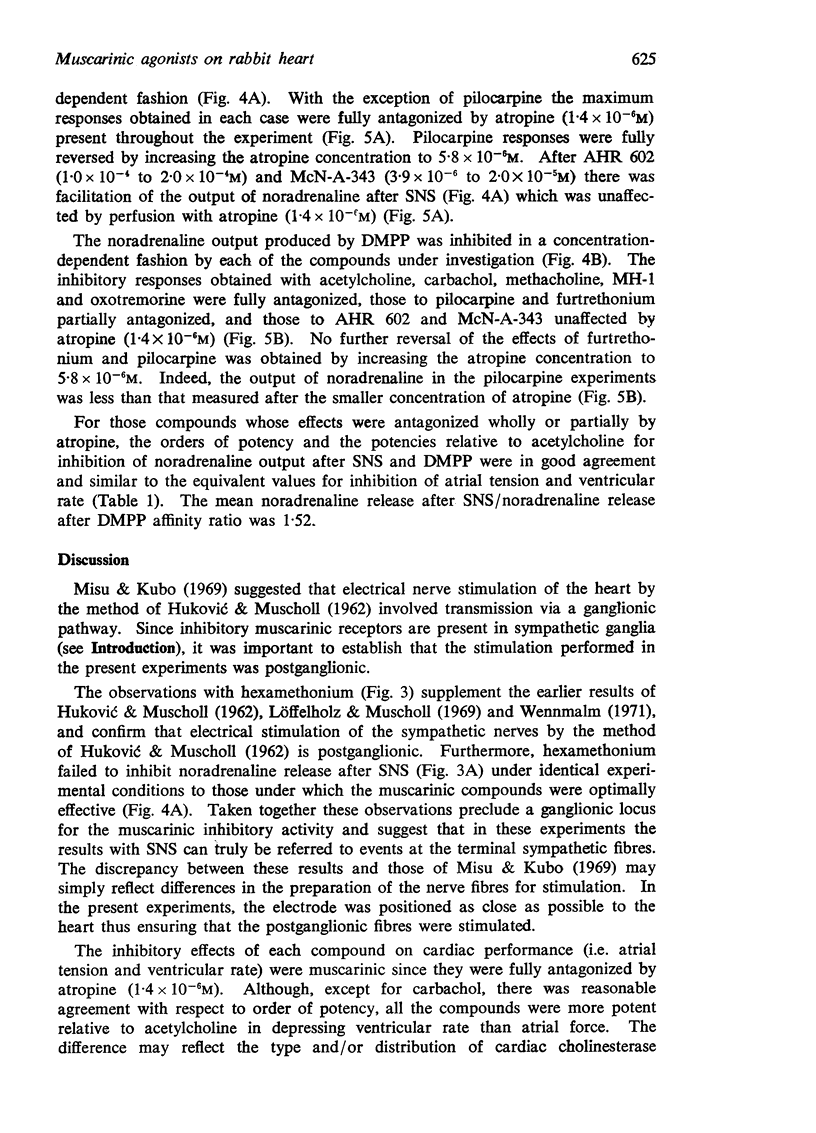
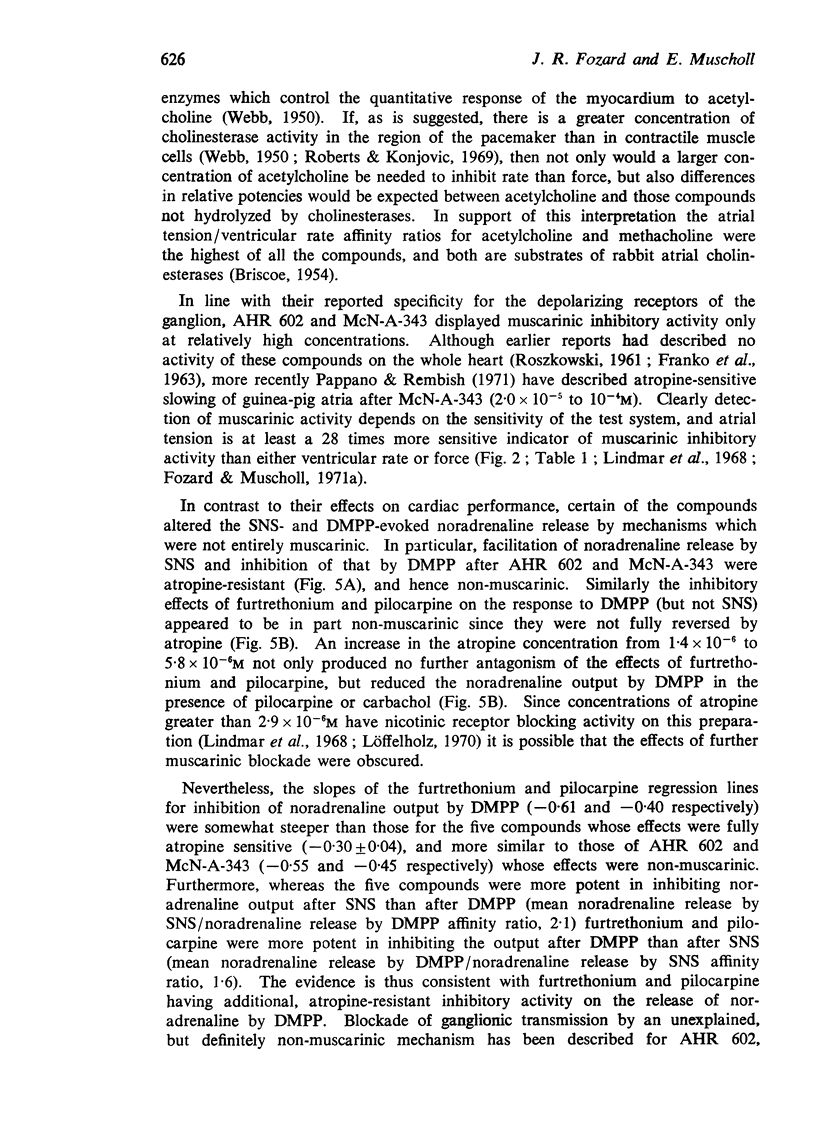

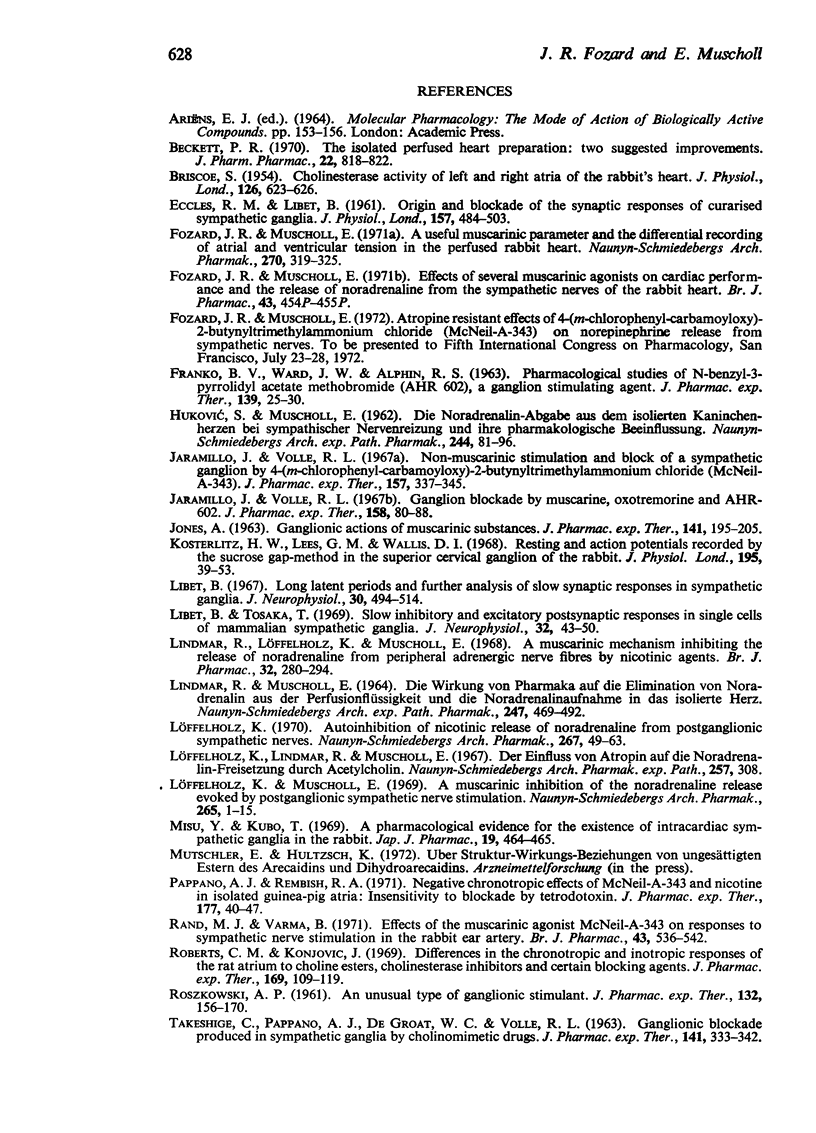

Selected References
These references are in PubMed. This may not be the complete list of references from this article.
- BRISCOE S. Cholinesterase activity of left and right atria of the rabbit's heart. J Physiol. 1954 Dec 10;126(3):623–626. doi: 10.1113/jphysiol.1954.sp005231. [DOI] [PMC free article] [PubMed] [Google Scholar]
- Beckett P. R. The isolated perfused heart preparation: two suggested improvements. J Pharm Pharmacol. 1970 Nov;22(11):818–822. doi: 10.1111/j.2042-7158.1970.tb08445.x. [DOI] [PubMed] [Google Scholar]
- ECCLES R. M., LIBET B. Origin and blockade of the synaptic responses of curarized sympathetic ganglia. J Physiol. 1961 Aug;157:484–503. doi: 10.1113/jphysiol.1961.sp006738. [DOI] [PMC free article] [PubMed] [Google Scholar]
- Fozard J. R., Muscholl E. A useful muscarinic parameter and the differential recording of atrial and ventricular tension in the perfused rabbit heart. Naunyn Schmiedebergs Arch Pharmakol. 1971;270(4):319–325. doi: 10.1007/BF01002343. [DOI] [PubMed] [Google Scholar]
- Fozard J. R., Muscholl E. Effects of several muscarinic agonists on cardiac performance and the release of noradrenaline from the sympathetic nerves of the rabbit heart. Br J Pharmacol. 1971 Oct;43(2):454P–455P. [PMC free article] [PubMed] [Google Scholar]
- JONES A. GANGLIONIC ACTIONS OF MUSCARINIC SUBSTANCES. J Pharmacol Exp Ther. 1963 Aug;141:195–205. [PubMed] [Google Scholar]
- Jaramillo J., Volle R. L. Ganglion blockade by muscarine, oxotremorine and AHR-602. J Pharmacol Exp Ther. 1967 Oct;158(1):80–88. [PubMed] [Google Scholar]
- Jaramillo J., Volle R. L. Nonmuscarinic stimulation and block of a sympathetic ganglion by 4-(m-chlorophenylcarbamoyloxy)-2-butynyltrimethylammonium chloride (McN-A-343). J Pharmacol Exp Ther. 1967 Aug;157(2):337–345. [PubMed] [Google Scholar]
- Kosterlitz H. W., Lees G. M., Wallis D. I. Resting and action potentials recorded by the sucrose-gap method in the superior cervical ganglion of the rabbit. J Physiol. 1968 Mar;195(1):39–53. doi: 10.1113/jphysiol.1968.sp008445. [DOI] [PMC free article] [PubMed] [Google Scholar]
- LINDMAR R., MUSCHOLL E. DIE WIRKUNG VON PHARMAKA AUF DIE ELIMINATION VON NORADRENALIN AUS DER PERFUSIONSFLUESSIGKEIT UND DIE NORADRENALINEUFNAHME IN DAS ISOLIERTE HERZ. Naunyn Schmiedebergs Arch Exp Pathol Pharmakol. 1964 Jul 28;247:469–492. doi: 10.1007/BF00329896. [DOI] [PubMed] [Google Scholar]
- Libet B. Long latent periods and further analysis of slow synaptic responses in sympathetic ganglia. J Neurophysiol. 1967 May;30(3):494–514. doi: 10.1152/jn.1967.30.3.494. [DOI] [PubMed] [Google Scholar]
- Libet B., Tosaka T. Slow inhibitory and excitatory postsynaptic responses in single cells of mammalian sympathetic ganglia. J Neurophysiol. 1969 Jan;32(1):43–50. doi: 10.1152/jn.1969.32.1.43. [DOI] [PubMed] [Google Scholar]
- Lindmar R., Löffelholz K., Muscholl E. A muscarinic mechanism inhibiting the release of noradrenaline from peripheral adrenergic nerve fibres by nicotinic agents. Br J Pharmacol Chemother. 1968 Feb;32(2):280–294. doi: 10.1111/j.1476-5381.1968.tb00972.x. [DOI] [PMC free article] [PubMed] [Google Scholar]
- Löffelholz K. Autoinhibition of nicotinic release of noradrenaline from postganglionic sympathetic nerves. Naunyn Schmiedebergs Arch Pharmakol. 1970;267(1):49–63. doi: 10.1007/BF00997114. [DOI] [PubMed] [Google Scholar]
- Löffelholz K., Muscholl E. A muscarinic inhibition of the noradrenaline release evoked by postganglionic sympathetic nerve stimulation. Naunyn Schmiedebergs Arch Pharmakol. 1969;265(1):1–15. doi: 10.1007/BF01417206. [DOI] [PubMed] [Google Scholar]
- Misu Y., Kubo T. A pharmacological evidence for the existence of intracardiac sympathetic ganglia in the rabbit. Jpn J Pharmacol. 1969 Sep;19(3):464–465. doi: 10.1254/jjp.19.464. [DOI] [PubMed] [Google Scholar]
- Pappano A. J., Rembish R. A. Negative chronotropic effects of McN A-343 and nicotine in isolated guinea-pig atria: insensitivity to blockade by tetrodotoxin. J Pharmacol Exp Ther. 1971 Apr;177(1):40–47. [PubMed] [Google Scholar]
- ROSZKOWSKI A. P. An unusual type of sympathetic ganglionic stimulant. J Pharmacol Exp Ther. 1961 May;132:156–170. [PubMed] [Google Scholar]
- Rand M. J., Varma B. Effects of the muscarinic agonist McN-A-343 on responses to sympathetic nerve stimulation in the rabbit ear artery. Br J Pharmacol. 1971 Nov;43(3):536–542. doi: 10.1111/j.1476-5381.1971.tb07183.x. [DOI] [PMC free article] [PubMed] [Google Scholar]
- Roberts C. M., Konjovic J. Differences in the chronotropic and inotropic response of the rat atrium to choline esters, cholinesterase inhibitors and certain blocking agents. J Pharmacol Exp Ther. 1969 Sep;169(1):109–119. [PubMed] [Google Scholar]
- TAKESHIGE C., PAPPANO A. J., DEGROAT W. C., VOLLE R. L. GANGLIONIC BLOCKADE PRODUCED IN SYMPATHETIC GANGLIA BY CHOLINOMIMETIC DRUGS. J Pharmacol Exp Ther. 1963 Sep;141:333–342. [PubMed] [Google Scholar]
- TAKESHIGE C., VOLLE R. L. MODIFICATION OF GANGLIONIC RESPONSES TO CHOLINOMIMETIC DRUGS FOLLOWING PREGANGLIONIC STIMULATION, ANTICHOLINESTERASE AGENTS AND PILOCARPINE. J Pharmacol Exp Ther. 1964 Dec;146:335–343. [PubMed] [Google Scholar]
- Trendelenburg U. Transmission of preganglionic impulses through the muscarinic receptors of the superior cervical ganglion of the cat. J Pharmacol Exp Ther. 1966 Dec;154(3):426–440. [PubMed] [Google Scholar]
- Volle R. L. On the mechanism of ganglionic blockade by methacholine. J Pharmacol Exp Ther. 1967 Oct;158(1):66–72. [PubMed] [Google Scholar]
- WEBB J. L. The action of acetylcholine on the rabbit auricle. Br J Pharmacol Chemother. 1950 Sep;5(3):335–375. doi: 10.1111/j.1476-5381.1950.tb00584.x. [DOI] [PMC free article] [PubMed] [Google Scholar]


